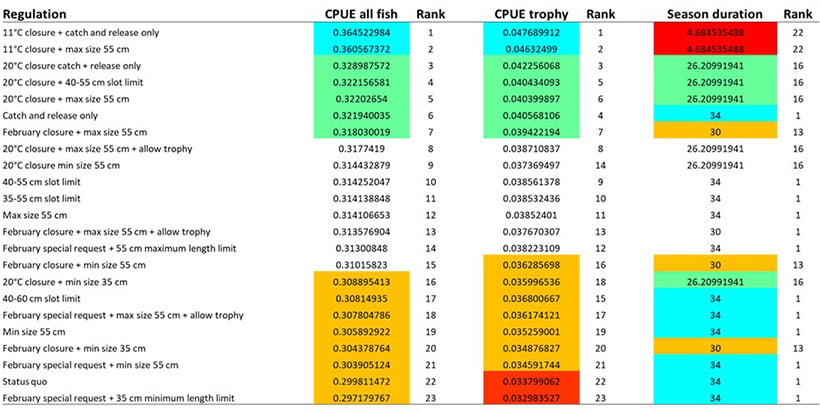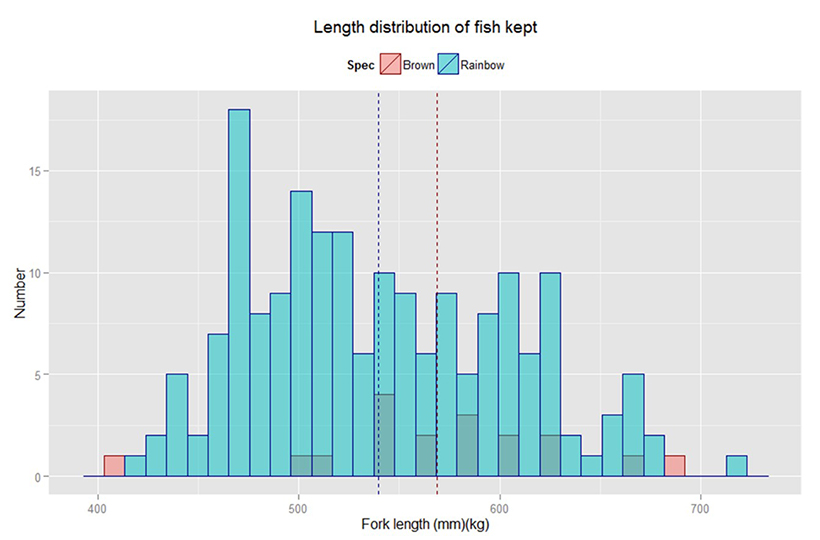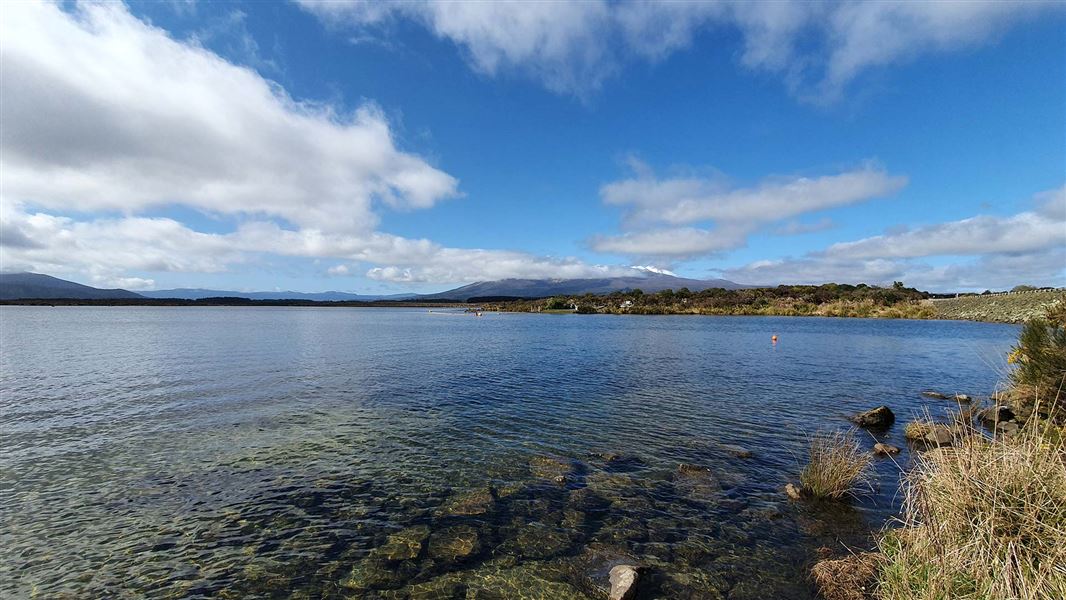Archived content: This media release was accurate on the date of publication.
Date: 01 December 2021
Report title: Management of Lake Otamangakau fishery in the face of various anglers’ aspirations, changing climate and evolving societal perception of recreational fishing.
Introduction
The main objective of this study is to apply a decision making process to support possible changes to fishing regulations during extreme environmental conditions. Twenty-seven years of research and monitoring provides us with a very good understanding of trout populations at Lake Otamangakau (Lake O), but we must also consider the following elements:
- Angler surveys indicate the fishing community is split between two distinct groups of anglers; those who want to catch less but larger fish and those who want to catch as many fish as they can. This dichotomy can create a substantial difficulty for managers as any decision may affect one group more than the other.
- The number of trophy fish (herein >650 mm) has declined steadily between 1994 and 2014 and it is now very low, probably no more than 100 specimens.
- Trophy fish at Lake O are large not because they grow fast but because they live a long time. To reach a trophy size they must be at least 5 to 6 years old, meaning that they grew and survived fishing pressure over a longer period.
- The fishing mortality includes fish that are killed voluntarily (harvested) and those that are killed involuntarily by releasing them after capture (catch-and-release).
- Fishing pressure is “the elephant in the room” affecting mortality. Even in the absence of harvest, mortality caused by catch-and-release may be sufficient to eradicate trophy fish if fishing pressure is sufficient. Fishing pressure (visits/year/hectare) estimated in Lake O is amongst the highest in New Zealand.
- Mortality associated with catch-and-release has been well studied worldwide but results are difficult to extrapolate as they are sometimes contradictory and/or specific to a geographic location. However, the major consistent driver of mortality is water temperature within which fish are played – the higher the temperature the higher the mortality. In Lake O catch and release mortality ranges from 0 to 30 % at water temperatures of <11 and >22 ˚C respectively. Furthermore, these estimations of catch-and-release mortality can be underestimated for several reasons. The number of times an individual trout was hooked and released wasn’t considered but with the current level of pressure in the lake, it is reasonable to expect that some fish that survived the first release may not survive an additional catch-and-release event. No data are available on the impact of repeat capture, but some studies suggest that if a trout had a 30 % chance of mortality after one capture event, the total probability of mortality after 2 hooking events could increase to 50 %. We don’t have any data on the number of times the same trout can be captured during its life. Mortality beyond 66 % cannot be ruled out, as several studies have shown that fish vulnerability to predation or susceptibility to disease can increase following catch-and-release.
- Elevated trout mortality at high water temperatures has pushed some fishery managers to close waters to recreational fishing when temperatures climb above a certain threshold. In most cases at 18 to 20 ˚C.
To explore what type of management action could be the most effective at maintaining anglers’ satisfaction levels and fish population perennity, we first used the biological aspects of trout runs collected over 20 years of trapping to build a dynamics model. We then submit this population to various degrees of fishing pressure, water temperature, changes caused by global warming and the corresponding catch-and-release mortality, into the model. The impacts of global warming were considered using 23 management regulation scenarios. We estimate these impacts on the catch rate of all fish, trophy fish and the duration of a fishing season. The outcomes of each scenario are presented in the table below.

Table 1. Outcomes and impacts of various fishing regulations for Lake Otamangakau on CPUE (fish/visit) of all sizes and trophy fish (>650 mm) and implications on the duration of the fishing season. | View larger (JPEG, 200K)
Results and discussion
The highest Catch Per Unit Effort (CPUE) would be expected with regulations allowing only catch-and-release combined with a closure of the fishery when the water temperature reaches 11 ˚C. This temperature threshold represents the condition when we observed no mortality caused by catch-and-release (commonly called “no kill”). However, such a regulation would dramatically reduce the fishing season restricting it to just over a month (4.7 weeks). The lake surface water temperature remains below 11 ˚C from April to November although this period will diminish with global warming.
Some anglers may suggest extending the fishing season to include the entire duration with water <11 ˚C. I think this would add another unnecessary stress on fish migrating to spawn and during the early phase of their recovery.
Note: For clarity and conciseness, I didn’t put the impact values of the increases in water temperature caused by global warming but considered scenarios with different rates of temperature increase per year. The results indicate that the rate of temperature change will negatively affect both the CPUE and the duration of the fishing season.
At the other end of the spectrum maintaining the status quo (doing nothing) or having a compulsory harvest of fish >350 mm in February would generate the lowest CPUE but would maximise the duration of the fishing season.
We believe that neither of these two options are desirable nor justified. We know that the number of fish in Lake Otamangakau has a negative impact on their average size, so aiming at no mortality (catch-and-release only and closure at 11 ˚C) could lead to an overpopulation of fish that would prevent the production of trophy fish and hence negate the benefit of a change in fishing regulation. On the other hand, not changing anything or relaxing harvest further could potentially reduce the fish population to levels where no trophy fish are available.
As we said earlier, there are several types of anglers fishing Lake O, with some who want to harvest fish for the table. We have analysed the length class distribution of the fish kept by anglers and we can see that the number of fish kept is small and that the average size is less than 550 mm indicating that anglers are not selecting trophy fish to harvest (Graph 1).

Graph 1. Length class distribution of the fish kept (n=269) by anglers recorded during angling survey (n=2343) carried out at Lake Otamangakau between 1997 and 2020. | View larger (JPEG, 121K)
Therefore, we are confident that allowing some harvest will not have a significant detrimental effect on the availability of trophy fish and that a catch-and-release only regulation is not warranted. However, even though the surveys indicate that virtually no angler seeks to harvest the allowed daily bag, I would suggest that reducing the daily bag to 2 fish would send the right message.
In fact, the outcomes of catch-and-release only without any temperature threshold closure will have a less positive impact on CPUE than allowing some harvest of fish with some size regulation and water temperature restriction.
Setting the threshold temperature at 20 ˚C for closing the fishery would have the best outcome but it presents some logistic problems and can have an unfair impact on anglers. The temperature in the lake can change quickly from one day to the next so it would be difficult to put in place and enforce such a rule. Furthermore, it would be unfair to those anglers who plan trips to Lake O at great expense, only to arrive and be prevented from fishing because the water temperature is over the threshold.
The continuous temperature monitoring indicates that the lake surface water temperature is highest from mid-January to mid-March. So having a fixed closure period covering February would be simpler to understand and easier to enforce.
Considering all the limitations and constraints of the various scenarios, I believe that having a maximum size of 550 mm combined with a February closure constitutes the best compromise to address the angler’s satisfaction and maintaining and protecting the trout population.
Even though the differences in CPUE outcomes between the different scenarios seem very small we must remember that the total fish mortality will be multiplied by the fishing pressure. The Lake O fishery is open access; therefore, the long-term effectiveness of the above regulation will be dependent on the unknown and unpredictable fishing pressure exerted.
Restrictions on angler effort may represent an important management option for maintaining the trout population. However, policies that seek to reduce fishing effort are often unacceptable and hence have rarely been implemented in recreational fisheries. In addition, reducing fishing effort will also mean less revenue from licence sales – the only source of income. Therefore, before reducing fishing pressure managers need to have a clear understanding of the financial impact, particularly when angling participation is in decline and managers need to retain current angler participation as well as recruit new anglers.
